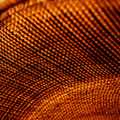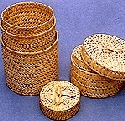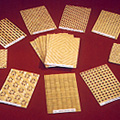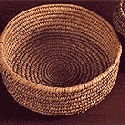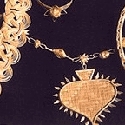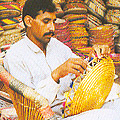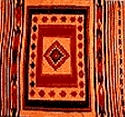Co-operatives of cane and bamboo workers have been formed in Poona and Bombay. They make lounge chairs and decorative and utilitarian products from cane and bamboo. Plastic and cane, both white and coloured, are increasingly being used for caning chair seats, backs, and tabletops. Bamboo baskets are also made in a number of places.
People in the Northeast have transformed bamboo and cane into houses, fencing, mats, baskets, tools, hats, sieves and even clothing items. The uses that bamboo and cane are put to varies among the people in the hills and the people in the plains of Manipur. In the plains, baskets and fishing traps are made in large quantities for commercial purposes. They are sold at the local haats or marketplaces. In the hills, cane and bamboo are used to craft furniture, household implements, and even houses, although many tribes today do make large quantities of cane and bamboo products for commercial purposes as well. Even the forms of the baskets vary between the hills and the plains. The hill people use their baskets to store food, grains, and clothes and for carting things over long distances. In the plains, the baskets are more decorative and less utilitarian. Tribal baskets are woven for personal use and have exquisite and intricate patterns worked on them. Among the variety of baskets, the chengbon has a domed lid made of bamboo. These have a square body of checks, in black and white, rest on four prominent legs and are used for storing clothes. Another special feature of Manipuri basket ware is the variety of bamboo fish traps which are exquisitely crafted. Besides baskets, bamboo is used to make a host of other items in this state. A village blacksmith, for instance, uses bamboo to make bellows and so does the weaver to make looms.
Abundant cane and bamboo grows in Meghalaya. It grows very fast and comes in many varieties. The artisans, mostly khasis, when free from agriculture, use this resource to build their houses, and make their implements, baskets, and objects of everyday needs. In Shillong, the capital of the state, houses are built on wooden stilts. These houses have walls made of a framework of wood and bamboo matting. The bamboo matting is made from rough strips of bamboo woven openly. This is put between two grids made from wooden strips or whole bamboo. The matting is plastered with a mixture of lime and sand till it gets a fairly thick coat. For the matting, the ekra variety of bamboo is used, which is found in large amounts in the Khasi hills. Khasi conical baskets (khoks) are a common sight in Meghalaya. Market day is a great event and all kinds of baskets filled with vegetables, fish, meat, rice, and bamboo shoots can be seen at every stall at the marketplace. Basic khoks or thugis, and artistic baskets, known locally as meghum khoks, are also made. This type of basket is used by the tribals to store valuable items, including clothes. A mixture of creosite oil is applied on the baskets to make them pest-proof. The khasis are famous for weaving cane mats, stools, and baskets and khasi umbrellas (locally known as kurup) are made in light and medium qualities. They make a special kind of cane mat called 'tlieng', which lasts for at least 20-30 years.
Mizoram is the home of the Mizos, which literally means dwellers of the hill top. The Lushai tribe is the single largest group, with the Pwoi and the Lakher being smaller tribes. The Mizos are all Christians. While women excel at weaving, men are experts at cane and bamboo work. Bamboo is found in abundance on the hills and the people of the region put it to several uses. Baskets are, of course, one of the most popular forms of craftsmanship with this material. Among the other products crafted from bamboo are houses, furniture, kitchen implements, agricultural tools, weaving tools, and even jewellery. Furniture items include chairs, tables, sofas, moorahs, and bamboo screens. Umbrella-handles, knitting needles, hats, mugs, fish baskets, rain shields, pipes, toys and games, hand-held pipes, and the back-strap loin-loom are all made from bamboo and cane. Mizo houses are generally built with bamboo walls and floors and thatched roofs. Houses that are over 100 years old can still be seen standing in Mizoram. Basket making is done mostly by the men and the products are uncommonly beautiful. Each home weaves its own baskets and it is only recently that basketry has become a commercial activity among the people of the region. The variety of styles and uses that the bamboo basket is put to is quite amazing. The conical bamboo basket called paikwang is a typical Mizo basket, broad at the rim and tapering at the bottom, and is used to carry firewood, cotton, vegetables, and other items. The paiem is a closed-weave basket and is used for carrying grain. It is woven with four long bamboo splints at the corners. The lower half of the basket is square and as it opens out at the top it becomes circular in shape. Baskets made of cane and bamboo, together with leaves and grasses, are also made.
Living in a land where bamboo and cane are plentiful, the Nagas are expert bamboo-weavers. So inextricably are the lives of the Nagas linked with cane and bamboo that it is said that: 'In Nagaland, life starts in a cradle of bamboo and ends in a coffin of bamboo.' Every person produces for his personal use; there are no professional weavers. The Naga youth are expected to learn and practise the Naga crafts. Collection of the raw material happens between July and October. The bamboo used is about a year old, for bamboo stems more than three years old are too brittle. The stems are cut and made into splints, depending on the end product and the nodes of the culms. They are then coloured, if necessary. Basketry among the Nagas is a highly developed art form It is prestigious for a Naga woman to carry a beautifully woven basket. Tradition states that a magician, Chang Kichaylangba, before he died, stated that if the people opened his grave on the sixth day after his death, they would discover something new. On the sixth day the grave was opened and all the designs and patterns of basketry work were found ----these are still being practised them. Each basket has its use, which determines its shape. The khopi is a basket of bamboo and is always carried by the Naga womenfolk irrespective of age. It has a footrest, and a jute belt and leather strap to fix the basket to the forehead. A basket without a footrest is a koshie. Conical carrying baskets, akhi and akha, for instance, are used to carry heavy loads across large distances, while flattened cylindrical baskets in twill patterns are used for straining the rice beer. This basket is so closely woven that it is water tight. Every household possesses several flat-bottomed big baskets for storing grain. The conical baskets are made from split bamboo and the splits are interlaced in a manner similar to threads interlaced in weaving. Chakhesang and Angami Nagas carrying baskets are well known. Beautiful baskets to carry balls of thread and knitting are used by the Chang women. Konyak baskets are decorated with figures and hair. Most household articles are made of soft wood and the is made of furniture of cane and bamboo. The Nagas are known for the cradles, tables, chairs, and sofas that they make from bamboo and cane. Other products include bamboo drinking mugs, beautifully embossed with various cultural motifs, bamboo mats, shields, hats, necklaces and amulets, and even musical instruments. A harp made of bamboo with a vibrating reed is made in Nagaland and Assam. A konyak belt once worn by an adult is not removed until death --- it absorbs the body oils and over time the belt turns a golden yellow in colour.
Cane or rattan is a kind of climbing palm which has long, thin, solid and many joined stems; it can grow to almost 500-600 feet. The main products made from cane are furniture, mooras or low seats, bowls and other household items. Once the green sheath is removed the stems are dried and heated to make them pliable. Cane splints interlace with cane rods to form supports to the furniture made. The main centres for cane products are Chennai, North Arcot and Thanjavur districts. Chennai is particularly well known for cane weaving and chairs, tables and chaise lounges. At Wallajapet and Anaikaranchatram decorative and useful items such as baskets and trays are made. Bamboo baskets are used by the farmers to store and carry food-grains and for packing and transporting fruits and flowers. Plaited basketry in Tamil Nadu is made by crossing the warp and the weft or two wefts. Plaited basketry is of various kinds: chequer work, twill work, wrapped work, intertwined work and hexagonal work. Chequer: when each strand passes alternately over and under two or more warps with variations in widths and colours. When the colours are different, a chequer board pattern emerges. Twill: warp and weft are of equal thickness and the weft passes over and under two or more warps producing diaper patterns using colour strands. Border weaving has three strand warp border, simple wrapped border and fastened twine. Borders are sometimes fixed to baskets with long cane strips. The decorative effects are obtained by simple lines, bends or spirally raised ridges.
The cane and bamboo craft exists in almost all the villages in the interior of Sikkim and the skilled artisans here offer a distinguished range of products.
Being one of the fastest growing plants and found in abundance all over the state, Bamboo is deeply embedded in several traditions of Sikkim and remains a decades old craft. Cane, grown in a limited area, is sourced from Siliguri, West Bengal and other regions in the North East. Although several areas in the North East dye the cane & bamboo, in Sikkim, painted cane & bamboo is more popular.
Known to exist in varied forms and sizes, the usage of cane & bamboo includes constructing some of most essential and commonly used products with minimal tools combined and interlaced with grass. The dual property of tensile strength and durability of bamboo also makes it an apt raw material for constructing homes, bridges, fences, furniture items – tables, chairs, moorahs to daily-use utility products such as basketry, containers, pen stands to name a few. Moreover, with innovative technology intervention, the use of bamboo & cane continues to be multi-fold. Dolls & toys, umbrellas, musical instruments, loom frames, figurines are some of the other products made with cane & bamboo in Sikkim.
It is interesting to note that specific types of cane & bamboo are used for particular objects – muli, a type of bamboo is used specifically for making umbrella handles. Pencil cane, on the other hand, is considered best for designing and binding. Moreover, it is also said that each district has their own distinct style of making basketry using this eco-friendly natural fiber. Several cutting tools, locally known as Dao, khukri as well as heat treatment are used to modify cane & bamboo to achieve the desired length, thickness, shape and smoothness. The artisans make the tools themselves or are sourced from Gangtok.
Cane or rattan is a kind of climbing palm which has long, thin, solid and many joined stems; it can grow to almost 500-600 feet. The main products made from cane are furniture, mooras or low seats, bowls and other household items. Once the green sheath is removed the stems are dried and heated to make them pliable. Cane splints interlace with cane rods to form supports to the furniture made. The main centres for cane products are Chennai, North Arcot and Thanjavur districts. Chennai is particularly well known for cane weaving and chairs, tables and chaise lounges. At Wallajapet and Anaikaranchatram decorative and useful items such as baskets and trays are made. Bamboo baskets are used by the farmers to store and carry food-grains and for packing and transporting fruits and flowers. Plaited basketry in Tamil Nadu is made by crossing the warp and the weft or two wefts. Plaited basketry is of various kinds: chequer work, twill work, wrapped work, intertwined work and hexagonal work. Chequer: when each strand passes alternately over and under two or more warps with variations in widths and colours. When the colours are different, a chequer board pattern emerges. Twill: warp and weft are of equal thickness and the weft passes over and under two or more warps producing diaper patterns using colour strands. Border weaving has three strand warp border, simple wrapped border and fastened twine. Borders are sometimes fixed to baskets with long cane strips. The decorative effects are obtained by simple lines, bends or spirally raised ridges.
Craftsmanship in Tripura is a unique blend of styles practised by different tribes and communities belonging to diverse religions. In its weaving, too, the region shows a similar fusion of styles, where the traditional patterns have meshed with Manipuri and Bengali styles brought in by craftspeople from these regions who have settled in Tripura. There are 12 major species of bamboo used in the region and each region and every tribe has its own use for the plant. The tribes, with a rich and varied culture, belong mainly to the Riang, Chakma, Halam, and Usai communities. The majority of tribals live in elevated houses of bamboo called 'tong'. The cane and bamboo handicrafts of Tripura are known for their elegance and exquisite designs. Bamboo is used to make furniture, panelling, mattresses, baskets, lamp shades, bags, moorahs, baskets, vases, mugs, pencil holders, tablemats, and other mat products. The tribes of the Northeast use baskets to transport and store a wide range of goods for day to day living --- firewood, water, chickens, grains, ornaments, and thread. A very high degree of skill is required to make the fine and perfectly woven baskets. Cane and bamboo are split vertically and made into extremely fine and uniform strips, using simple tools. The waxy top layer is used while the inner layer, which is fibrous and rougher than the outer layer, is removed. The bamboo is then stripped down to the required thickness and length. The splits are dextrously woven to form a large array of forms and shapes. Artisans also produce smaller versions of utilitarian items with very fine bamboo splits. These come in an infinite variety of weaves and are exquisite. In western Tripura men can be seen weaving the kula, dala, and tokri to store vegetables. Winnowing trays and fans are formed by making a mat into the desired shape. Every third strip uses the outer layer of bamboo. Pollo, a fish trap, is made of bamboo splits that are 6 mm by 4 mm in cross section. Sudha is a fish trap used by the Jamatia tribe of Tripura. It consists of a bamboo net suspended from crossed splints. Dulla is a commonly used fish basket. Pathee is a rain shield similar to the japi of Assam. Mats and mat articles like the bamboo 'chatais' are also among the well-known crafts of the region. There are different types of roll mats used as door and window screens as well as room partitions.
Bamboo is a widely available grass which is very handy to use. It grows easily on marginal and wastelands and replenishes itself within 6 months. it is versatile and can be used to build an entire house as well as weave as small a basket. Bamboo plantations conserve soil and water and improve soil;l fertility and local climate. Bug bamboo which is generally called Boans are traditionally not cultivated by the villagers of Uttarakhand owing to the superstitions associated with it being used to carry the dead to the cremation ground,. Village artisans design and weave bamboo baskets and winnows of various sizes and shapes each fulfilling the needs of specific farming activities, right from sowing, harvesting, and collecting to drying and storing. The user often seals some of them with a coat of local cow dung, these baskets are sold further afield through local shopkeepers in market centers. Other itmes such as the baskets. winnows, hand fans are made out of the bamboo products and sold to the local community and the others.

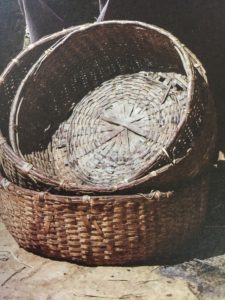




Mutra cane is the raw material for shitalpati and it grows mainly in Cooch Behar. This is kept soaked in water for 24 hours and is then cut into strips to make the pati. Some of the strips are dyed magenta in colour to make patterns. Shitalpati is woven with flat strips in simple checks, twill, zig-zags, diagonals, diamonds, and many other designs, and the motifs woven in the mats are stylised human, animal, or leaf designs mainly in magenta, using the extra weft technique. Cane is also used to make baskets. Traditional shapes like the dhama, dhami, and katha are made. Cane baskets are made with a species of thin cane found mainly in north Bengal. The core material is a whole cane twisted into spirals which curve out gracefully from the base to the rim. The cane is stitched together in simple lines with thin strips of the cane itself. These are very sturdy and are used to carry heavy loads of grain. The cane baskets with a heavy plaited weave are used all over West Bengal to carry head loads of bricks and stones. Bamboo, used mainly for basketry, grows abundantly in West Bengal. Craftspersons sometimes have their own bamboo groves adjoining their huts. The variety of bamboo used for basketry has long fibres and widely-spaced internodes. When the bamboo is solid and thick and has close nodes it is used for construction. In north Bengal a thick but hollow variety is flattened to make the wall panels of village huts. Bamboo containers --- which are smoked to a brown shade, decorated with poker work, with designs burnt in with a red hot point of a steel tool, bound by strips of cane, and fitted with cane handles --- are used to store, carry, and measure oil and milk in many parts of north Bengal. In the hill regions, bamboo lengths are halved, the nodes are removed, and these are used as aqueducts to carry water. The bamboo strips used in basket weaves are flexible and their width determines the appearance of the basket. Paddy bins or containers for storing paddy are usually made of bamboo matting. These are large and have a graceful waist with a cylindrical shape which is the basic structure of the bin. The bamboo which is used for this is slatted, and seasoned by soaking it in a mud bed for three to four weeks.
Jewellery made from forest-based cane and bamboo involves extremely intricate detailing and is the specialty of artisans from the northeastern region of India. It uses the technique of interlacing two or more strands of the material in different ways, akin to the process of coiling or braiding. Assam, Tripura and Arunachal Pradesh are famous for their cane & bamboo ornaments.
Cane and Bamboo ornament making is practiced all across the three states of Arunachal Pradesh, Asaam and Tripura. However, there are always regional variations present
Colloquially called Baans bareilly due to its huge cane and bamboo mandi(market),Bareilly is famous as a production center for cane furniture. Articles such as furniture, dustbins, racks, lamps, baskets, pot holders, sofa sets and center tables are part of the huge repertoire of items produced. Tools used for the crafting process range from saw, kerosene lamp, hammer to knife.
Many centres like Allahabad, Barely, and Varanasi make baskets and other articles from bamboo, cane, and raffia. Each centre has its own style in the use of raffia, locally referred to as mooj. This grass is usually grown on field edges so that it acts as a fence and also keeps stray animals away. The outer stalks of the mooj grass are sun-dried and preserved in tin or wood containers for use. This craft is a part of family tradition and every daughter starts acquiring basket-making skills from an early age. The wide range of bamboo, cane, and raffia products include baskets, trays, wall decorations, and furniture
Cane and bamboo, which since ancient times have provided the raw material for basketry, mats, and other utilitarian items, including furniture, are essentially rural crafts connected with the everyday needs of people. The tall golden white sarkanda grass growing around Delhi and Haryana has made these a centre for the manufacture of chairs and moorahs or stools. Closed baskets, lounge chairs, waste-paper baskets, and trays of various sizes are also made and sold. The long strips of sarkhanda grass are cut and tied in a criss-cross fashion. They are then wrapped with wheat straw to hold them together. This is covered with a cord made out of munj grass or brightly coloured cotton or plastic. The colour binding makes these chairs more attractive.
Basket making is a home based craft across the Himachal The baskets are made by professional basket makers as well as by the women of Pahari households during the winter months. They are sold at the local fairs and weekly markets, at the Dussehra Festival and during the marriage season. Baskets are used to store, carry, work and for other functional purposes. Elaborately woven and strong the baskets are made of bamboo and other locally grown grasses such as the nargal (a thin grass). Load-bearing baskets are made from local wood-stemmed grasses - the toong , a thick grass found in the higher reaches of the mountains that is used for reinforcement, and nargal. Other grasses used are the chupod (a soft grass),phhagad (a hard grass);banana fibres or palm leaves. The techniques utilized in the construction of the basket vary according to the purpose of the basket but are usually combinations of coiling, interlacing and plaiting.
The using of natural fibres for making mats, baskets and other products is one of the oldest crafts practised in Pakistan. For centuries artisans have woven, moulded, twisted and stitched a variety of fibres to provide products for numerous purposes.
The specialities of the furnishing fabrics from Cannanore or Kannur are their compact structure and texture of cloth, unique colour combinations, wide width (90-120 inches) and skilled craftsmanship. The fabrics range from stripes and checks to floral or geometrical designs, with woven borders, manufactured from cotton or art silk or in combinations of both. The handlooms of Cannanore produce a wide variety of home furnishings such as bed linen, bath linen, kitchen linen, cushions and suchlike.
Navalgund a small town in the Dharwar district is where the most colourful dhurries are woven. Earlier it was a weaving centre for woollen carpets but as wool became more expensive there was a switch to cotton dhurrie weaving. The motifs remain the same, and geometrical and floral designs abound. Navalgund dhurries are characterised by unusual patterns and stunning colours. Although these are cotton dhurries, yet the bright and lustrous colours used make them look far from ordinary. The art of dhurrie weaving has been passed down from one generation to the next. Families guard craft techniques even from their own daughters (who do not practise the craft). However, attempts are being made to introduce production on a more efficient and regular basis. A special dhurrie called sutada is made in Bijapur and Dharwar districts of Karnataka. This has simple, horizontal stripes of different colours. In Mulgund and Murgao of Dharwar district, a special dhurrie is made by joining together various nine-inch pieces of coloured cloth. Inspiration for the motifs is derived from wall paintings and wooden miniatures. Special designs are made for festive occasions.



